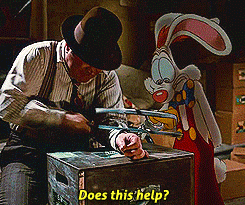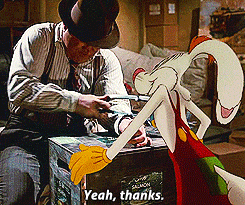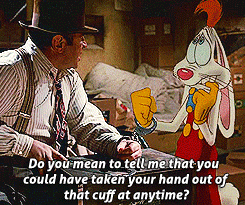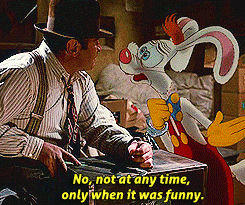dalziel86:siphersaysstuff:benpaddon:nerdgerhl:I feel like there are probably too many people just sc
dalziel86:siphersaysstuff:benpaddon:nerdgerhl:I feel like there are probably too many people just scrolling past this so let’s go through everything that’s going on here. 1. With Roger’s voice actor standing off camera, Bob Hoskins acts into empty air and frantically sawing at his handcuff, continually looking up and down at different visual marks of various depths. Look at the slow pan up of his eyes in gif 4, and then the quick shift to his side. Think about how, on set, he was looking at nothing. 2. Starting in gif 2, The box must be made to stop shaking, either by concealed crew member, mechanism, or Hoskins own dextrousness, as he is doing all of the things mentioned in point 1. 3. In all gifs, Roger’s handcuff has to be made to move appropriately through a hidden mechanism. (If you watch the 4th gif closely you can see the split second where it is replaced by an animated facsimile of the actual handcuff, but just for barely a second.)4. The crew voluntarily (we know this because it is now a common internal phrase at Disney for putting in extra work for small but significant reward) decided to make Roger bump the lamp and give the entire scene a constantly moving light source that had to be matched between the on set footage and Roger. This was for two reasons, A) Robert Zemeckis thought it would be funnier, and B) one of the key techniques the crew employed to make the audience instinctually accept that Toons coexisted with the live action environment was constant interaction with it. This is why, other than comedy, Roger is so dang clumsy. Instead of isolating Toons from real objects to make it easier for themselves, the production went out of its way to make Toons interact more with the live action set than even real actors necessarily would, in order to subtly, constantly remind the audience that they have real palpable presence. You can watch the whole scene here, just to see how few shots there are of Roger where he doesn’t interact with a real object. The crew and animators did all of this with hand drawn cell animation without computerized special effects. 1988, we were still five years out from Jurassic Park, the first movie to make the leap from fully physical creature effects to seamlessly integrating realistic computer generated images with live action footage. Roger’s shadows weren’t done with CGI. Hoskin’s sightlines were not digitally altered. Wires controlling the handcuff were not removed in post. Who fucking Framed Roger fucking Rabbit, folks. The greatest trick is when people don’t realize you’re tricking them at all. Let’s also not forget that writing. “Only when it was funny” isn’t just hilarious, it’s great comedy theory. It lampshades the joke, but also serves to remind the viewer that Toons have a separate set of physical laws they adhere to, mostly revolving around comedic value. Roger cannot remove his hand from the cuffs… until it’d get a laugh from an audience.Everything about this movie, EVERYTHING about it, is so finely crafted. I could wax lyrical about it for days.Who Framed Roger Rabbit is one of my all-time favorite movies. Hands down.On the surface level, it’s amazing. I saw it as a kid in the theater, and was blown away. It was hilarious, it was scary. It was a love letter to the era of cartooning and noir crime stories. It did what many considered a “never in a million years” scenario: Bugs Bunny and Mickey Mouse, the bajillion-dollar symbols of rivals WB and Disney’s cartoon empires, sharing the screen together in cooperation. Think of the “holy shit” factor when the latest Smash Bros game reveals a major non-Nintendo character is in it, multiplied by about a billion because this shit never happened back then. This may not have been the first improbable cinematic crossover, but damn if it wasn’t one of the biggest, if not THE biggest.(Plus of course Daffy and Donald Duck’s amazing piano duel, and closing the film with both Porky Pig and Tinkerbell in their famous signoffs.)It was a technical marvel, making you forget the sheer amount of work that had to go into integrating the toons into the film. For the technology of the time, even when there’s rough-around-the-edges bits, it’s an amazing accomplishment in practical effects and hand-drawn animation that I appreciate more and more.If you haven’t seen it, please, do so. If it’s been a while… see it again.Let’s also not forget its integration of the real-world Los Angeles history of freeway-building and the disruption of minority communities. This shit is DEEP. -- source link
Tumblr Blog : teflonly.tumblr.com
#long post





